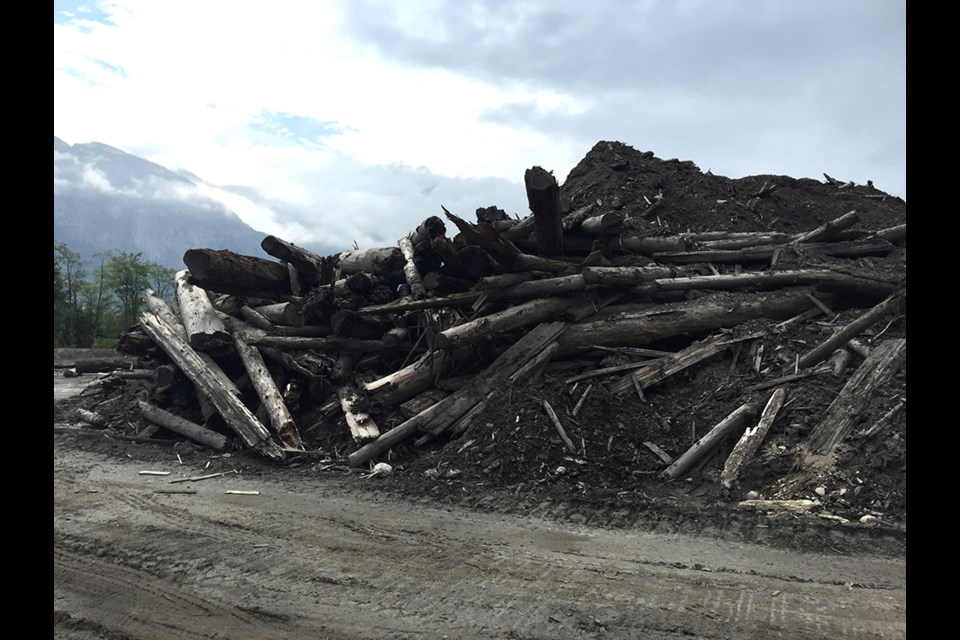The question of accountability is at the centre of a debate between Councillor Susan Chapelle and leaders of the not-for-profit Squamish River Watershed Society over the West Barr Restoration Project in the Squamish Estuary.
“The community should know why the estuary looks the way it does right now, and the problems,” said Chapelle.
According to Chapelle, the work on the old log sort resulted in hydrocarbons being released and a pile of cedar that she estimates will cost $100,000 to dispose of due to tipping fees.
“This all began four months ago,” she said. Chapelle said she went for a walk through the estuary and saw a huge pile of wood, and on another walk thought she smelled fuel, which she said turned out to be a hydrocarbon leak. Chapelle said she tried to get an explanation from the society at the time but was rebuffed. Although members of the society did eventually meet with Chapelle on June 1, she isn’t satisfied.
“I totally get that they are trying to remediate the estuary and I think that is fantastic… but… this is our public estuary.”
Chapelle said even though the society is undoubtedly well intentioned, the work in the estuary should have been subject to the same public process as the FortisBC application to drill holes in the estuary for pipeline route exploration.
Chapelle wants to know how the woodpile is going to be dealt with, because it can’t go to the district landfill, she said.
“My only point is that process must be accessible, fair and equal to anyone who is dealing with our district and its land,” said Chapelle.
Edith Tobe, executive director of the Squamish River Watershed Society, said the work in the estuary started March 7 and has been moving forward as expected.
“From early on, Councillor Chapelle has been contacting us and wanting me to tour her personally around the site, and we actually had planned a site tour with her and all of council early on… but we found a little hydrocarbon, and I mean little, about 30 square feet under where the old fuel tank was located,” she said. “We had the province come out immediately and had it assessed… and removed the contaminated material.”
A provincial spokesperson told The Squamish Chief that the society’s restoration plan was reviewed and approved by the province.
The province is monitoring the entire cleanup project and providing technical expertise when needed, according to
the spokesperson.
Tobe said the discovery was not unexpected but delayed the council tour.
“Ever since we delayed… not a day has gone by that I have not been in damage control with [Chapelle], with her jumping to outrageous conclusions.”
In terms of the woodpile, Tobe said the waste was found almost as soon as the project started, “which was not unexpected, but we had not anticipated it would be there. We had hoped the site would be left in a cleaner state from the former log handling association… but the reality is we found a layer of wood waste that we have to remove because it is not conducive to fish habitat and the work we are doing.”
The wood has been stockpiled at the north end of the site with the intention of moving it off site, she said.
“We have been in discussion with the province and with the district of Squamish staff,” she said, adding the district has some options for locations to transport the wood waste on district land. She said the local wood waste facility would charge tipping fees so they are looking for other options.
Provincial representatives are also trying to find a suitable, cost-effective disposal option for the wood waste, according to a government spokesperson.
District of Squamish general manager Gary Buxton said the restoration project is part of the Squamish Estuary Management Plan.
“The work is being managed and overseen federally by Department of Fisheries and Oceans, provincially by Ministry of the Environment and Ministry of Forests, Lands and Natural Resource Operations, and Squamish Nation, in concert with Squamish River Watershed Society,” Buxton said.
Buxton said a development permit such as what was required for FortisBC to do route exploration would not be necessary for the society’s restoration work.
“Conversely, restoration works rehabilitate disturbed, impacted areas back to functional ecological habitat,” he said, adding that the restoration work exceeds development permit guidelines.
Mayor Patricia Heintzman said the estuary remediation has been well handled.
“The people leading this project are some of the most experienced people in the province at this type of work,” she said.
“We are so lucky to have this provincially recognized expertise in Squamish and such a strong collaborative approach to a complicated project like this one.”
Squamish Nation spokesman Chris Lewis said the Nation has been involved with the remediation work.
“Squamish Nation is playing a critical role in the team effort to restore the estuary and has been doing so since 1991,” Lewis said.
The Squamish Chief was unable to reach a West Barr representative prior to the press deadline.



